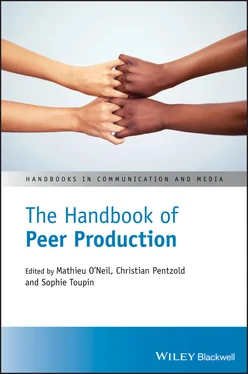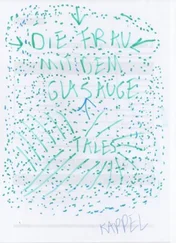Peer production is not a “gift economy” and it is not fully based on reciprocity. Peer production follows the adage: each contributes according to their capacities and willingness, and each takes according to their needs. Thus, any “gifting” is most often non‐reciprocal gifting, i.e., the use of peer‐produced use‐value does not create a reciprocal obligation. Peer production does not usually involve reciprocity between individuals but only between individuals and the collective resource. For example, people are allowed to develop their software based on an existing piece of software distributed under the widely used GNU General Public License, only if their final product is available under the same kind of free and open source license (in this case, GNU General Public License).
Peer production can most easily operate in the sphere of digital goods, where the main inputs are free time and the available surplus of computing resources. Reciprocity‐based schemes are necessary in the material sphere where the higher cost of capital intervenes. At present, peer production offers no coherent solution to the material survival of its participants, though as we discuss below, there are some promising solutions to such challenges. Therefore, many people inspired by the egalitarian ethos will resort to cooperative production, the social economy, and other schemes from which they can derive an income, while honoring their values. In this sense, these schemes are complementary. The open cooperative and the platform cooperative movements, however, showcase how peer producers may make a sustainable living (Bauwens et al., 2019; Scholz & Schneider, 2016).
In peer production, people voluntarily and cooperatively construct shareable resources that are governed according to the principles and norms of the productive community, i.e., a commons. The use‐value created by peer production projects is generated through free cooperation, without coercion toward the producers, and users have free access to the resulting use‐value. The legal infrastructure that we have described above creates digital commons of knowledge, software, design, and culture. These new commons are related to the older form of the commons (most notably the communal lands of the peasantry in the Middle Ages and of the original mutualities of workers in the industrial age), but they also differ from them, mostly through their largely intangible characteristics. The older commons were localized, used, and sometimes regulated by specific communities (Ostrom, 1990); the new commons are available and regulated by global cyber‐collectives, usually affinity groups. While the older forms of physical commons (air, water, etc.) increasingly function in the context of scarcity, thus becoming more regulated, the digital commons are non‐rival resources enriched through usage (thus they could even be considered “anti‐rival”).
Michel Bauwens (2005) suggested that P2P processes aim to increase the most widespread participation by equipotential (“equal” + “potential”) participants. The processes of peer production are characterized by the adoption of equipotentiality as an organizing principle. This means that everyone can potentially cooperate in a project, and, thus, in principle no authority can pre‐judge the ability to cooperate. The quality of cooperation is then judged by the community of peers, i.e., through communal validation. In equipotential projects, participants self‐sort themselves into the module to which they feel able to contribute.
A related term, used by Jimmy Wales (2014) of the Wikipedia project, is anti‐credentialism, which refers to the fact that no credentials are asked beforehand. This means that there is no a priori selection to participation. What matters is the ability to carry out a particular task, not any formal a priori credential. The capacity to cooperate is verified in the process of cooperation itself. Thus, projects are often open to all comers provided they have the necessary skills to contribute to a project. These skills are verified, and communally validated, in the process of production itself. Reputation systems may also be used for communal validation. The filtering is a posteriori, not a priori. Anti‐credentialism is therefore to be contrasted to traditional peer review, where credentials are an essential prerequisite to participate. However, the “expert” is not a persona non grata in peer production (O’Neil, 2010). Rather, equipotentiality, through a process that is far from flawless, allows the crowds to engage with experts to produce content, designs, code, and more.
Another element of the grammar of peer production is that projects are characterized by holoptism, as opposed to panopticism (Foucault, 1977) in which only a centralized power can see the whole. Holoptism, from the Greek o&c.rcomab;λος (“whole”) and o&c.comabr;πτικος (“seeing”), is the implied capacity and design of peer production processes that allows participants free access to all the information about the other participants; not in terms of privacy, but in terms of their existence and contributions (i.e., horizontal information) and access to the aims, metrics, and documentation of the project as a whole (i.e., the vertical dimension). This can be contrasted to the panopticism that is characteristic of traditionally hierarchical projects: processes are designed to reserve “total” knowledge for an elite, while participants only have access on a “need to know” basis. In peer production, communication is not top‐down and based on strictly defined reporting rules, but feedback is systemic and integrated in the protocol of the cooperative system.
3.5 Stigmergic Cooperation
In peer production some producers may be paid or employed as wage labor, or work for the market as freelancers, but not necessarily. All of them produce a commons. The work is not directed by the corporate hierarchies, but through the mutual coordination mechanisms of the productive community, to which the corporate hierarchies have to defer if they want to participate in this type of production. Peer production is based on open and transparent systems, in which everyone can see the signals of the work done by others, and can, therefore, adapt their contribution to the needs of the system as a whole.
Peer production is often based on “stigmergic,” from the Greek στίγμα (“mark, sign”) and the έργον (“work”), cooperation. In its most generic formulation, stigmergy is the phenomenon of indirect communication among agents and actions (Marsh & Onof, 2007, p. 1). Think how ants or termites exchange information by laying down pheromones (chemical traces). Through this indirect form of communication, these social insects manage to build complex structures such as trails and nests. An action leaves a trace that stimulates the performance of a next action, by the same or a different agent (ant, termite, or commoner in the case of peer production). Therefore, in the context of peer production, stigmergic collaboration is the “collective, distributed action in which social negotiation is stigmergically mediated by Internet‐based technologies” (Elliott, 2006). For example, see how free and open source software code lines and the Wikipedia entries are produced in a distributed and ad hoc manner through contributions by large numbers of people.
3.6 Modularity, Granularity, and Low‐Cost of Integration
Other authors have of course made significant contributions to the grammar of peer production. For example, stigmergic collaboration is enabled by three characteristics, identified by Benkler (2006) as embedded in the social design of a peer production project: modularity, granularity, and low cost of integration. To begin with, the project needs to be broken down into smaller components, i.e., into modules. For example, in Wikipedia the content is divided into entries, sections, and paragraphs. People can contribute from one word to thousands of words (or figures). The modules allow for any size of contribution: there are many levels of granularity to match different levels of contributors’ motivation and time availability.
Читать дальше


![О Генри - Справочник Гименея [The Handbook of Hymen]](/books/407356/o-genri-spravochnik-gimeneya-the-handbook-of-hymen-thumb.webp)









